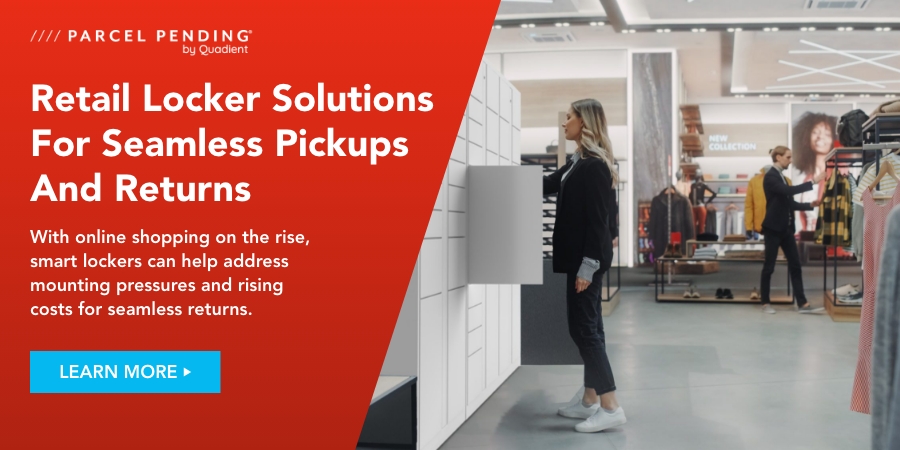Our Blog
What is a Fulfillment Center?
Written by: Parcel Pending
6 Min Read
Published: April 10, 2019
Updated: February 4, 2024
Third-party logistics (3PL) providers, also referred to as fulfillment service providers, utilize multiple fulfillment centers to help eCommerce retailers complete order processing or order fulfillment for online orders. Below, we’ll discuss how fulfillment centers and fulfillment services operate and why adding a parcel locker solution might be an ideal solution for an eCommerce business or brick-and-mortar retailer to support the order fulfillment process, reduce fulfillment fees (and shipping costs!), and improve customer satisfaction.
What Is a Fulfillment Center?
So, what is an eCommerce fulfillment center? As online shopping and overnight delivery became a more critical facet of a retailer’s success, many retailers soon realized that there simply was no logistical way to store all their inventory in one location. There was not enough warehouse space, nor was there a centrally located spot that made it possible to ship orders next– day or overnight.
In response, many companies started building or investing in fulfillment centers in various places (often referred to as hubs) around the country. These buildings are spaced out and located by key shipping and supply chain hubs (such as those owned by UPS or FedEx, or a fulfillment company such as Amazon or Shopify) in order to minimize delivery times and shipping costs, as well as streamline the customer order fulfillment process.
How a Fulfillment Center Works
So what is order fulfillment how do fulfillment centers tie into the process? Whether outsourcing fulfillment service or operating an in-house fulfillment warehouse, this is a crucial part of order processing.
A fulfillment center, not to be confused with a distribution center, helps complete the online order process. There, an online retailer stocks their inventory, stores it, and sends it out when a customer places an order. Once a customer makes a purchase, the fulfillment company notifies the fulfillment center closest to them that an order needs to be prepared. Warehouse staff find the inventory, package it, label it, and ship out the customer order. A fulfillment warehouse can process orders for:
- B2B – Business-to-business customers, where high volume orders (e.g., bulk or wholesale orders) are sent to retailers.
- B2C – Business-to-consumer customers, where orders are shipped directly to a customer’s home.
Many retailers choose to outsource their eCommerce fulfillment to a third-party logistics or outsourced fulfillment provider so that they can focus on selling more products, fulfilling orders quickly, and improving customer service. An outsourced fulfillment provider or fulfillment company saves them from having to manage their own inventory, negotiate shipping rates with carriers, and fulfill orders.
Fulfillment Center vs. Warehouse: What is the Difference?
A fulfillment center is different from a warehouse in that it is a complex and continuously moving supply chain operation and facility. A warehouse space is simply a static inventory storage space. Unlike warehouses, fulfillment centers provide services ranging from:
- Receiving inventory
- Grouping goods into a unit
- Palletizing
- Locating goods
- Packing and shipping boxes
- Labeling packages
- Shipping customer orders
- Handling returns
However, like a fulfillment center, it is important to ensure your warehouse is running efficiently to help ship orders in a timely manner as well as reduce fees and enhance quality.
What is a Micro Fulfillment Center?
Where order fulfillment centers are as large as 300,000 square feet and typically located in rural areas, micro fulfillment centers are normally 3,000 to 10,000 square feet and located closer to the customer, cutting down on costs associated with the fulfillment operation and delivery time.
Over the past few years, a new micro fulfillment option has emerged in the form of “dark stores” – a fulfillment center where store owners or an eCommerce company can process goods and returns rather than a place for customers to browse and shop. Turning vacated retail space into a fulfillment center allows behemoth retailers and eCommerce retailers to create delivery hubs in the middle of cities (and closer to customers) that typically prohibit new construction.
By leveraging multiple fulfillment centers, retailers can slash delivery times for online orders, allowing the product to reach customers in just a few hours versus a day. In short, flexible fulfillment options matter. In fact, a recent analysis concluded that micro fulfillment could reduce order-related costs by as much as 75%.1
Fixing Inventory Management Problems
An inefficient fulfillment process is one of the fastest and most common ways to lose business and decrease customer satisfaction, especially for larger brands. Common problems within these operations include:
- Inventory Discovery – Disorganized warehousing or an uncommunicative third-party logistics provider can make it very difficult to locate specific pieces in inventory. An inefficient item location process can lead to delays and slow down delivery times.
- Damaged or Incorrect Items – If a customer receives the wrong item or a damaged item, that could create a sense of distrust towards the company they purchased the item from, and could even result in them taking their business to a competitor. Proper inventory management, storage protection, and packaging combined with thorough item inspection can prevent such issues from occurring.
- Shipping Notifications – Customers have grown accustomed to being able to monitor their shipment at all times, knowing both exactly where it is and exactly when to expect it. A lack of transparency around order status can lead to customer dissatisfaction and increased customer service calls.
- Poor Inventory Management – A fulfillment center that does not keep close tabs on its inventory levels may sell out of an item before realizing it. As a result, customers order the item, expect it, and only later are informed that it is out of stock or will take longer than expected. Lack of oversight is an easy way to lose customers and sales.
How Parcel Lockers Can Help
However your eCommerce company chooses to operate this aspect of its business there’s a solution that can streamline the process in-store or at convenient delivery hubs in retail storefronts.
That fulfillment option is known as Buy Online, Pick-up in Locker (BOPIL) by Parcel Pending. When figuring out how to improve in store experience, taking advantage of providing this offering can increasingly help your business. With this technology, customers place their order online, the fulfillment center ships their order to a nearby brick-and-mortar store, and places the item(s) in the electronic locker for the customer to retrieve at their convenience.
Customers are increasingly likely to use a smart parcel delivery system because:
- Their orders are securely stored (unlike home deliveries)
- Shipping costs are significantly reduced or completely eliminated
- Delivery time is reduced to a matter of hours as opposed to several days
- Customers are instantly notified by text or email when their order is ready
- Allows for express, contactless order pick-up in less than 2 minutes
Many retail stores prefer this method, as it optimizes order fulfillment by:
- Reducing shipping and fulfillment costs, as well as times associated with home delivery
- Providing a convenient, self-service BOPIS option for customers
- Improving order status transparency with full chain of custody visibility
- Indicating which orders have been picked up and which items can be returned to the shelf
- Keeping orders safe and secure until customers are ready to retrieve them
Retailers using BOPIL have saved an average of 45 hours per month that were previously spent managing BOPIS orders.2 Most importantly, with BOPIL, 61% of customers make an incremental purchase just by virtue of entering the store!
Efficient Fulfillment Is Key
An efficient, streamlined fulfillment center is critical to a retailer’s success. Disorganization and lack of oversight can lead to significant delays and slower shipping times. If you want to improve your order fulfillment services, smart retail lockers are an easy, scalable method to streamline the order fulfillment process and keep customers happy. Lockers also help companies realize significant savings by reducing the cost of last-mile delivery.
Looking for a service to help optimize your fulfillment process? Learn more about our retail locker solutions here.
Sources:
- Devanesan, Jon. TechHQ. Retailers turn to the micro fulfillment center to keep supply chains flowing. (2021, February 22). https://techhq.com/2021/02/retailers-turn-to-the-micro-fulfillment-center-to-keep-supply-chains-flowing/.
- Reidel, Kate. Parcel Pending. Omnichannel Retail Strategy: Bringing Online Shoppers to Brick & Mortar Stores. (2020, June 1). /en-us/blog/omnichannel-retail-strategy-bringing-online-shoppers-to-brick-mortar-stores/.




